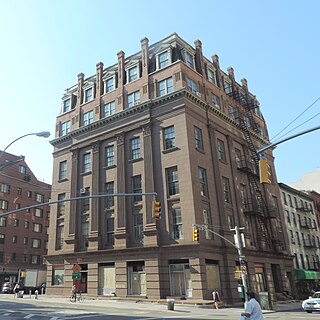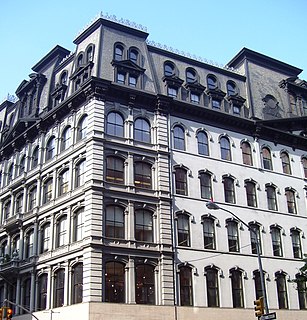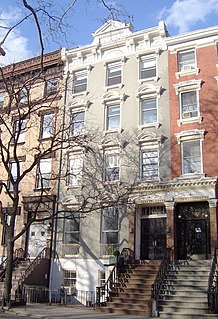Related Research Articles

Skadden, Arps, Slate, Meagher & Flom LLP and Affiliates is an American multinational law firm headquartered in New York City. Founded in 1948, the firm consistently ranks among the top U.S. law firms by revenue.

Drexel Burnham Lambert was an American multinational investment bank that was forced into bankruptcy in 1990 due to its involvement in illegal activities in the junk bond market, driven by senior executive Michael Milken. At its height, it was a Bulge Bracket bank, as the fifth-largest investment bank in the United States.

Brown Brothers Harriman & Co. (BBH) is the oldest and one of the largest private investment banks in the United States. In 1931, the merger of Brown Brothers & Co. and Harriman Brothers & Co. formed the current BBH.
James Joseph "J. J." Haverty was the founder of Haverty Furniture Co., headquartered in Atlanta, Georgia.

George Frederick Pelham was an American architect and the son of George Brown Pelham, who was also an architect.

280 Broadway – also known as the A.T. Stewart Dry Goods Store, the Marble Palace, and the Sun Building – is a historic building located between Chambers and Reade Streets in the Civic Center district of Manhattan, New York City. Built in 1845-1846, it was the first commercial building in the Italianate style in New York City, and is considered the site of one of the nation's first department stores. 280 Broadway was designed by John B. Snook of Joseph Trench & Company, with later additions by other architects. It was built for the A. T. Stewart Company, which opened New York's first department store in it. It later housed the original New York Sun newspaper (1833–1950) and is now the central offices for the New York City Department of Buildings.
Jonathan Greenleaf Eveleth founded the first oil company in America with George Bissell in 1854. Partners in the Wall Street law firm of Eveleth & Bissell, the two formed the Pennsylvania Rock Oil Company with 5 other investors from New York, New Haven, and Titusville, Pennsylvania, to "raise, procure, manufacture, and sell Rock Oil."
Wertheim & Co. was an investment firm founded in 1927 by Maurice Wertheim and Joseph Klingenstein, who met when they worked together at Hallgarten & Company. The firm engaged primarily in the merchant-banking business; it invested from its formation until the deaths of Wertheim and one of his senior partners in 1950 and 1952 respectively.
Roosevelt & Son was an American investment banking firm connected with the Roosevelt family for nearly two centuries. The firm was among the oldest banking houses on Wall Street. Many of the male members of the Roosevelt family worked for the firm in some capacity.

The Odd Fellows Hall is a building at 165-171 Grand Street between Centre and Baxter Streets, in the Little Italy and SoHo neighborhoods of Manhattan, New York City. It was built in 1847-48 and designed by the firm of Trench & Snook in the Italianate style, one of the city's earliest structures in this style, which Joseph Trench had brought to New York with his design for 280 Broadway in 1845. His partner, John B. Snook, was responsible for many cast-iron buildings in SoHo. The mansard roof was an addition, designed by John Buckingham and built in 1881–82. The Independent Order of Odd Fellows used the building until the 1880s, when they moved uptown with the city's population. The building was afterwards converted for commercial and industrial use.
E. W. Clark & Co. was a banking and financial firm founded in Philadelphia, Pennsylvania, United States, in 1837 by Enoch White Clark. Among its partners were American Civil War financier Jay Cooke and West Philadelphia developer Clarence Howard Clark.

Stephen Decatur Hatch was a prominent late-19th century architect who was responsible for a number of historically or architecturally significant buildings in Manhattan, New York City and elsewhere. He primarily designed commercial buildings.
The brothers David, John E. and George Elliott Jardine were architects of Scottish nationality, sons of a Scottish architect-builder, Archibald Jardine, of Whithorn, Wigtownshire; they took up American citizenship and practiced in New York City, forming "one of the more prominent, prolific and versatile architectural firms in the city in the second half of the 19th century". From 1865 they practiced as David and John Jardine or D. & J. Jardine, later taking into partnership their brother George Elliott Jardine. At David's death in 1892 the firm was reorganized as Jardine, Kent & Jardine and then practiced as Jardine, Hill & Murdock.

John Butler Snook (1815–1901) was an American architect who practiced in New York City and was responsible for the design of a number of notable cast-iron buildings, most of which are now in and around the SoHo neighborhood of Manhattan, as well as the original Grand Central Depot, which preceded the current Grand Central Terminal.

The Baumann family was a family of American architects who practiced in Knoxville, Tennessee, and the surrounding region, in the late 19th and early 20th centuries. It included Joseph F. Baumann (1844–1920), his brother, Albert B. Baumann, Sr. (1861–1942), and Albert's son, Albert B. Baumann, Jr. (1897–1952). Buildings designed by the Baumanns include the Mall Building (1875), the Church of the Immaculate Conception (1886), Minvilla (1913), the Andrew Johnson Building (1930), and the Knoxville Post Office (1934).

Arnold Constable & Company was a department store chain in the New York City metropolitan area. At one point it was the oldest department store in America, operating for over 150 years from its founding in 1825 to its closing in 1975. At the company's peak, its flagship "Palace of Trade" in Manhattan – located at 881-887 Broadway at East 19th Street, through to 115 Fifth Avenue – was acknowledged to be the store which took the largest portion of the "carriage trade", in New York, serving the rich and elite of the city, such as the wives of Grover Cleveland, Andrew Carnegie, Thomas Edison, J.P. Morgan, John D. Rockefeller and Cornelius Vanderbilt.

The East 10th Street Historic District is a small historic district located in the Alphabet City area of the East Village neighborhood of Manhattan, New York City. It includes all 26 buildings, numbered 293 to 345, on East 10th Street between Avenue A and Avenue B, across from Tompkins Square Park. The district was designated by the New York City Landmarks Preservation Commission on January 17, 2012.

Joseph Trench (1815-1879) was an American architect who practiced in New York City and San Francisco in the 19th century.
The Morgan family is an American family and banking dynasty, which became prominent in the U.S. and throughout the world in the late 19th century and early 20th century. Members of the family amassed an immense fortune over the generations, primarily through the noted work of John Pierpont Morgan (1837-1913).
Prime, Ward & King was a prominent American investment bank in the 18th and 19th Century based in New York City.
References
- Notes
- ↑ Brazee, Christopher D. and Most, Jennifer L. "Architects Appendix" to the "East 10th Street Histyoric District Designation Report", New York City Landmarks Preservation Commission (January 17, 2012)
- ↑ "NYCLPC NoHo Historic District Designation Report" (June 29, 1999), p.219